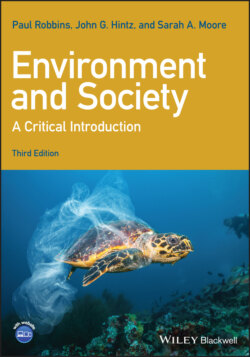Читать книгу Environment and Society - Paul Robbins - Страница 44
The Bet
ОглавлениеCan using more stuff lead to the availability of more stuff? Can human population growth be good for both nature and society? By the end of the 1970s, when population-centered thinking was dominant, such questions were counterintuitive and hard to even ask. At that time, Paul Ehrlich was the most prominent spokesperson for the population crisis and was typically identified as the paramount and persuasive neo-Malthusian of the time (Chapter 2). His book, The Population Bomb (1968), was a cornerstone of the thinking and rhetoric of many environmentalists.
It may have seemed surprising, then, for Ehrlich to be challenged to a very public bet in 1980 by a thinker largely unassociated with environmentalism, at least in the public mind. The wager came from economist Julian Simon, who had long maintained that human population growth improved living conditions and environmental quality, because 1) more people means more good ideas, and 2) more demand for things (including clean air and water) produces an incentive to find, make, and creatively maintain the world. His thinking culminated in a controversial article in the journal Science in 1980, entitled “Resources, population, environment: An oversupply of false bad news” (Simon 1980), which maintained that things get progressively better, not worse, with the advent of every birth.
As a journalist for the New York Times recorded a decade later (Tierney 1990), the wager consisted of the men betting $1000 on whether the prices of five metals selected by Ehrlich and his associates – chrome, copper, nickel, tin, and tungsten – would rise or fall in value over the next decade. If Simon was right and the planet was one where the future was always better than the present, the scarcity of these goods would actually decline, owing to increasing human ingenuity and economic growth. If Ehrlich was right and the planet was a finite place bedeviled by rampant consumption, prices should rise considerably. After all, the 1980s was predicted to be a decade of unprecedented growth, with more people born, more quickly, than at any time in human history.
Ehrlich lost the bet. The prices of all five commodities fell dramatically as new sources for each were found and new substitutions for each were developed in laboratories and factories around the world. For Simon, it appeared to vindicate a view of the world wholly different from that of end-of-the-world Malthusian environmentalism (Sabin 2013).
Of course, questions might be asked about the real environmental value of such a bet, and certainly have been in the decades since. To what degree had these two men really “bet the planet?” Had they not really only wagered on the commodity prices of a handful of relatively trivial ecological assets? What if they had bet on whether global temperatures or atmospheric concentrations of greenhouse gases would rise or fall? What would the future hold for these commodities and others as population continued to grow at an expanding rate?
Nevertheless, Simon had, in a very public way, conveyed a view of the relationship between nature and society that was rather different than that of population-centered thinking. Simon’s essential economic worldview was reflected in this bet. Beyond its essential optimism, this view held at its heart the creative potential of human beings, the importance of incentives in producing outcomes, and the utility of price for not only measuring but also creating brave new worlds (Field 2005).
